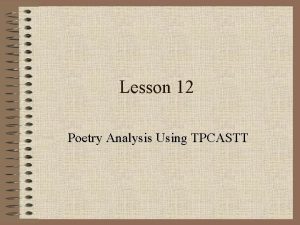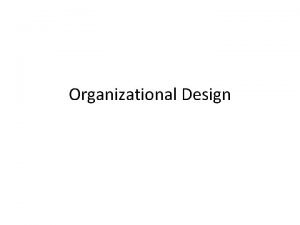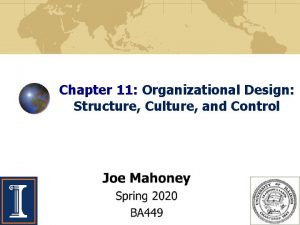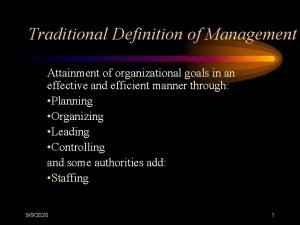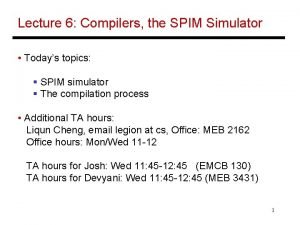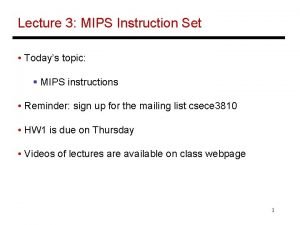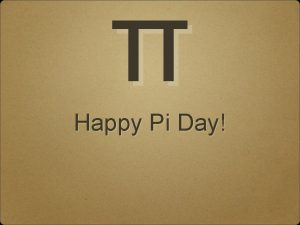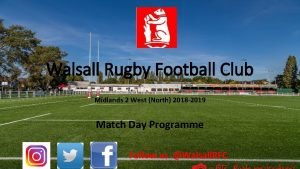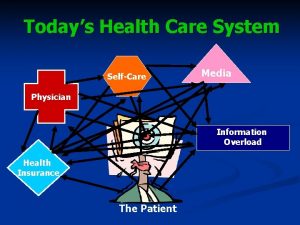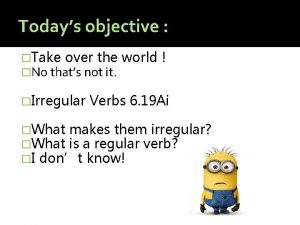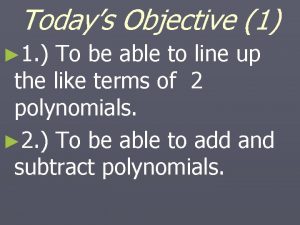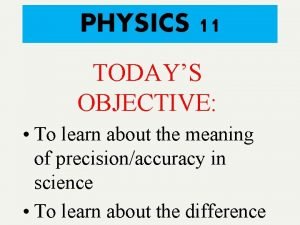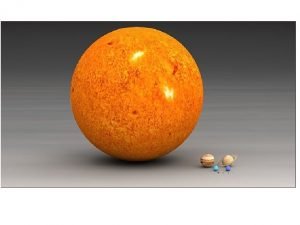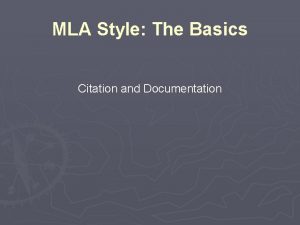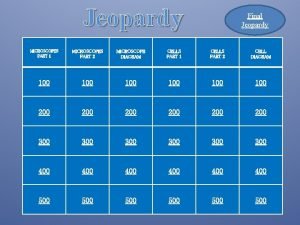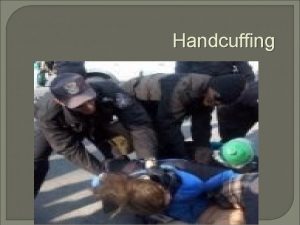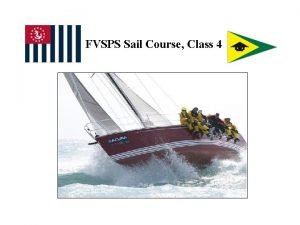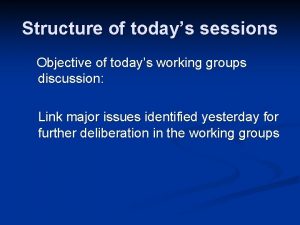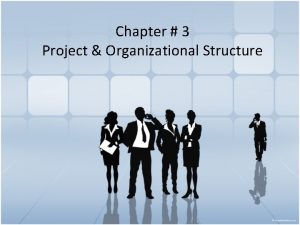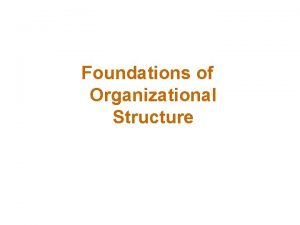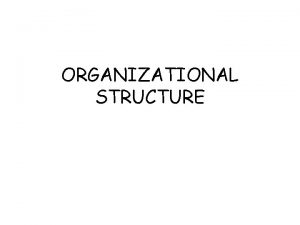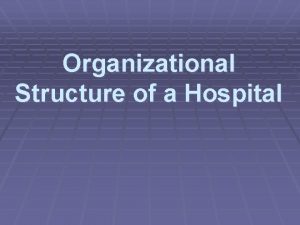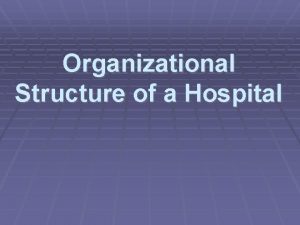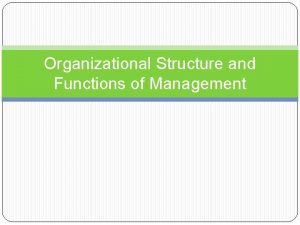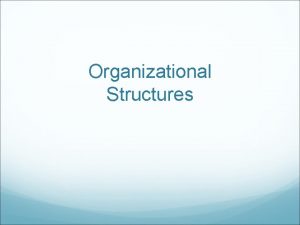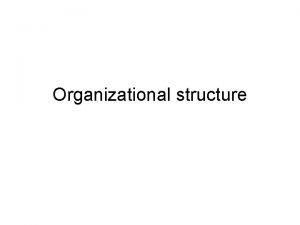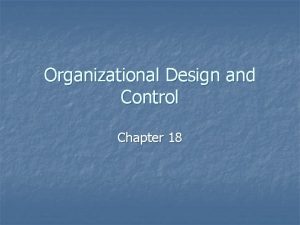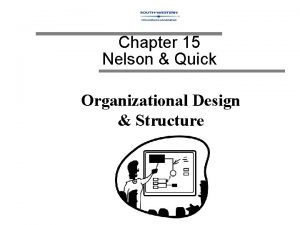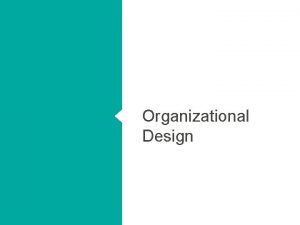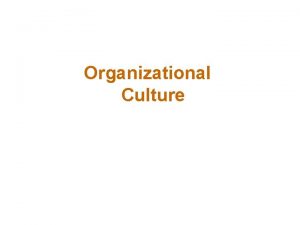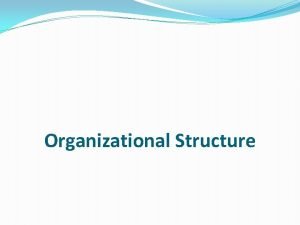Todays Agenda Organizational Structure Design Three goals of






































- Slides: 38

Today’s Agenda • Organizational Structure & Design – Three goals of structure – Understand relationships between environment, strategy and structure • SMA MEPD – Team case presentations 1

Open Systems Model Transformation Processes Inputs Interactions of: Environment • Formal Org Strategy • Informal Org • Tasks Resources • Individuals History Outputs Individual behavior Group behavior Organizational functioning Feedback 2

The Three Goals of Structure • Efficiency – minimize costs, time, effort • Coordination – coordinate diverse organizational tasks – ease information flow • Adaptability/Flexibility – scan environment – change to meet environmental needs 3

Ø Designing Organizations is the process of purposefully configuring the elements of the organization to foster the achievement of valued business, customer, and employee, community and environmental outcomes. SM 14 J (4)

Design at All System Levels Inter-Organizational Corporate/ System Wide Business Unit Inter-Unit Team, Work Unit, or Work Process SM 22 I (5)

Why is organization design important? Ø Ø Ø Ø Resources are aligned or misaligned with strategy and priorities. Coordination is efficient or inefficient—resource use is optimized or resources are wasted. Performance capabilities are enabled or disabled—quality, speed, innovation, growth Work is hard or easy to do—people are frustrated or feel well utilized. Customer interfaces are effective or ineffective—high value is delivered or not. Human capital is developed, motivated, and retained or stagnates, becomes cynical and “departs”. Societies, communities, and ecologies are strengthened or depleted SM 194 P (6)

Learning Two: Organizations are designed to fit a context, not a recipe (7)

Star Model Strategy Work Processes/ Capabilities People Structure Management Processes Rewards Behavior Performance Culture Adapted from: J. Galbraith SM 107 T (8)

Self-Design and the Star Strategy Laying the Foundation Valuing Acquiring Knowledge Diagnosing W P S R C R I T E R I A Designing W P S R Implementation & Assessment M M SM 106 T (9)

Work Processes/ Capabilities: The Link Between Strategy and the Design Features of the Organization What are the capabilities that are required to carry out the strategy? What work processes underpin those capabilities? At the rest of the points of the star you will be designing the features of the organization that enable the organization to do these well. SM 29 W(10)

Organizational Capabilities, examples: Ø Taking advantage of resources around the world to accelerate the development and commercialization of a steady stream of new products for a global market Ø Leveraging technology advances across multiple product and service units Ø Developing best solutions for customers, sometimes incorporating products and services from other companies Ø Acquiring and rapidly integrating small firms in order to expand rapidly advance product and service offerings Ø Managing and accelerating the transition to new technologies, products and services that will replace current core business SM 47 T(11)

Organizational Capabilities Ø The know-how that enables the organization to achieve its intended outcomes and implement its strategy. Ø Capabilities are composite bundles of competences, skills and technologies, rather than single discrete skills or particular jobs. Ø They are deeply embedded in an organization, including in its work processes, organizational frameworks, communication channels, human resource systems, problem-solving and decisionmaking strategies. SM 47 T(12)

Learning Three: Hierarchical structure is necessary but insufficient in a dynamic and complex environment. (13)

Hierarchical, Functional Organization General Manager Director of Engineering Manager Software Engineer etc. Manager Hardware Engineer Director of Marketing Manager Tech Support etc. QA Manager QA Specialist Manager Product Marketing QA Specialist Director of Manufacturing Manager Marketing Support Manager Mfg Engineer Administrative Director Manager Operations etc. Manager HR etc. Testing Manager Mfg QA Manager Training Specialist etc. Manager Info Systems etc. Comp & Benefits Manager Mfg Testing Manager etc. Finance Manager Comp. Specialist Benefits Specialist Comp. Analyst SM 34 I(14)

Processes Cut Across Core Units SM 24 E(15)

Managing complexity effectively requires an organization to be highly skilled at designing and managing various approaches to the lateral organization (16)

Team-Based Organization Executive Team Process Teams Councils Shared Services Team Leadership Team Business Unit 1 Process Team Team Leadership Team Business Unit 2 Cross Unit Opportunity Teams Process Team Team SM 50 T(17)

Networks Executive Team Integrating Councils Shared Services Management Team Unit 1 Integrating Teams Team SM 33 M Team Management Team Unit 2 Opportunity Team Knowledge Network (18) Integrating Teams Team

Build Rich Network Connections Network connections: § Provide rich sources of learning § Challenge built in assumptions and perspectives § Allow the combination of knowledge that may result in innovation § Can serve as support systems § Accelerate change implementation processes by enabling self-regulation rather than top down control

Open Systems Networks During Change Universities Customer Suppliers Local S. D. “Organization-Wide” Self-Designing Change Activities Local S. D. Customer Local S. D. Customer Partners Industry Associations

Learning(s) Four: Most organizational change programs do not accomplish their objectives. Yet change capability is critical in today’s World. Change can be accelerated, But it takes time and focus. (21)

Domains of Focus: Capability Development Create a critical mass of change skills and knowledge Talent and Knowledge Engage in and learn from change Organization Design Implementing and Learning Create change architectures leveraging common tool sets, models, and language and integrating OD, technical change and strategy processes

Learning Practices During Transition Shared Meaning Systemic View Dialogue, Conversation, Discussion Self-Design Learning from Experience SM 1 L (23)

Leader Responsibilities During Transition Focusing the Organization Vision Communication of Expectations Accountability Sense-Making Leading Learning Developing Capabilities Organization Architecture Initiatives to Develop Capabilities Resources Defining the New Employment Relationship SM 2 L (24)

Engage In and Learn From Change Practices that Accelerate Learning Building models, language, and practices that promote shared meaning Providing a systemic view of the organization Asking “what did we Leader Responsibilities During Transition Promote initiatives and resources that develop new capabilities Lead Learning Through Dialogue, Conversation, and Discussion learn from that experience? ” Encouraging groups to self-design their units Deliver consistent messages that focus the organization “Connect the dots” to make sense of events Offer opportunities to develop in ways that define a new employment relationship

Examples of Practices that Accelerate Learning • Principles, processes and language. • Strategy • Business Case • • Business models Balanced score cards Process models Whole system design • Organizational assessments and redesigns • Reviews and renewals • • • Performance feedback Renewals Company visits Conferences Communities of Practice • Surveys • Experiments Leader Responsibilities During Transition Focusing the Organization Shared Meaning Systemic View Self-Design Learning from Experience Dialogue, Conversation, Discussion Leading Learning Developing Capabilities Defining the New Employment Relationship Sense-Making • Continuity and consistency of messages and direction. • Goals and expectations • Performance metrics and reviews • • • Initiatives Resources Training and development Cognitive frameworks Empowering • Employees have a true stake in the organization. • Define the new relationship • Opportunities to grow and develop • Create a broad context in which to understand local changes. • Frameworks • Business case SM 71 M (26)

Change Implementation Occurs at All Systems Levels Inter-Organizational Corporate/ System Wide Business Unit Individual Team, Work Unit, or Work Process

Case Question 1 • What are the sources of the intergroup and inter-functional challenges in MEPD?

Case Question 2 • What changes in the business environment require higher levels of integration and more elaborate integrating mechanisms?

Case Question 3 • Assess MEPD’s approach to differentiation and integration. What linking mechanisms do they use, and how effective are these? Analyze other structural dimensions and how they might be contributing to the problems being experienced.

Case Question 4 • What should MEPD do (especially structurally) to address the problems you have identified?

Structural Design Dimensions of Organizations • (Structural) Differentiation: How are activities divided? – Vertical differentiation (hierarchy of authority) – Horizontal differentiation (specialization, e. g. product, process, function, geography) – Complexity (number of activities or subsystems) • Integration: How are activities coordinated/linked? – – Centralization (hierarchical level of decision making) Span of control (# of products, processes, functions supervised) Formalization (amount of written documentation) Standardization (degree similar work is done in uniform manner) 32

Issues in Differentiation of Subsystems • • Differences in time orientation Differences in objectives Differences in interpersonal orientation Differences formal structure Divisional (Product or Market, etc. ) Structure President Product Group 1 R&D Mfg Acct Product Group 2 Mkt R&D Mfg Acct Product Group 3 Mkt R&D Mfg Acct Mkt 33

Structural Integrating Mechanisms 34

Non-structural Integrating Mechanisms 35

Degree of Vertical Coordination and Control Required Vertical Linkages Vertical information systems High Add positions to hierarchy Rules and plans Hierarchical referral Low High Information Capacity of Linkage Mechanism 36

Horizontal Linkages High Degree of Horizontal Coordination Required Teams Full-time integrators Task forces Liaison roles Direct contact Information Systems Low High Costs of Coordination 37

SMA Lessons • Structure should follow strategy – MEPD’s structure has become misaligned with its strategy and market conditions • Structure shapes interactions and accountability inside the organization – Structure influences communication patterns and quality – Split accountability and control leads to conflict • Linking mechanisms can compensate for mismatches, but only so far! 38
 Strategic goals tactical goals operational goals
Strategic goals tactical goals operational goals Strategic goals tactical goals operational goals
Strategic goals tactical goals operational goals Todays agenda
Todays agenda Characteristics of a firewall
Characteristics of a firewall Agenda sistemica y agenda institucional
Agenda sistemica y agenda institucional Software organization structure
Software organization structure Organizational design: structure, culture, and control
Organizational design: structure, culture, and control General goals and specific goals
General goals and specific goals Examples of generic goals and product-specific goals
Examples of generic goals and product-specific goals Traditional definition of management
Traditional definition of management Generations
Generations There is class today
There is class today Multiple choice comma quiz
Multiple choice comma quiz Todays worldld
Todays worldld Whats thermal energy
Whats thermal energy Todays globl
Todays globl Whats todays wordlw
Whats todays wordlw Chapter 13 marketing in today's world
Chapter 13 marketing in today's world Todays plan
Todays plan Todays sabbath lesson
Todays sabbath lesson Welcome to sabbath school
Welcome to sabbath school Veseyans rfc
Veseyans rfc Todays health
Todays health Todays objective
Todays objective Todays objective
Todays objective Today's objective
Today's objective Todays whether
Todays whether Todays vision
Todays vision Todays objective
Todays objective Todays planetary position
Todays planetary position Title page example mla
Title page example mla Todays final jeopardy
Todays final jeopardy Todays objective
Todays objective Todays weather hull
Todays weather hull Todays objective
Todays objective Wat is todays date
Wat is todays date Todays objective
Todays objective Animal digestive system parts and functions
Animal digestive system parts and functions Todays objective
Todays objective


